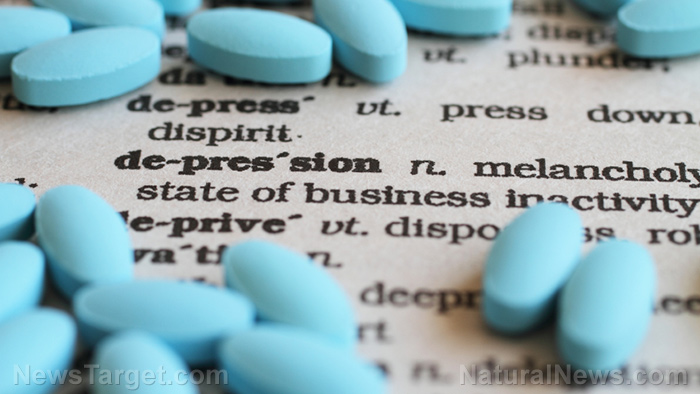Common household chemicals linked to America’s depression epidemic
By willowt // 2025-04-11
Tweet
Share
Copy

- A JAMA Network Open study found six chemical categories (nicotine metabolites, VOCs, metals, ethylene oxide, glycidamide, acrylamide) in blood/urine correlate with higher depression risk. These toxins — found in food, cleaning products and furniture — trigger systemic inflammation, disrupting brain function and mood regulation.
- Younger individuals and men show heightened susceptibility, explaining rising depression rates in males. Children and pregnant women face greater risks due to developmental sensitivity; toxins like BPA, phthalates and lead are tied to perinatal depression and ADHD.
- Farmers exposed to pesticides have up to 90% higher depression rates. PCBs (still lingering in electronics) and air pollution (ozone, PM2.5) worsen depressive symptoms in adults and adolescents.
- An Iowa farmer’s suicide coincided with annual pesticide use, mirroring research on chemical-linked depression. Lead exposure in childhood doubles the odds of adult depression, per a 2009 study.
The invisible threat: Chemicals in everyday life
The landmark study analyzed 3,427 adults recruited through the National Health and Nutrition Examination Survey (NHANES), the premier health assessment program run by the National Center for Health Statistics. Scientists examined blood and urine samples for 27 different environmental toxicants, using the specialized 9-item Patient Health Questionnaire (PHQ) to measure depression levels. The results were alarming: six specific toxicant categories showed direct links to increased depression risk:- Metabolites from nicotine
- Metabolites from VOCs (volatile organic compounds)
- Metals
- Ethylene oxide
- Glycidamide
- Acrylamide
Demographic vulnerabilities
The research revealed that younger individuals and men face particularly high vulnerability to toxicant-induced depression. This explains the mysterious surge in depression among American males, which has baffled conventional psychiatrists focusing exclusively on psychological and social factors. For parents, this research sounds an urgent alarm bell—children’s developing brains and bodies are even more susceptible to these pervasive chemicals than adults.Case study: Agricultural workers and pesticides
At 55 years old, Matt Peters, an Iowa farmer, took his own life. His wife, Ginny, noticed that every year his mood shifted towards depression in the spring, coinciding with the time he sowed pesticide-treated seeds. While this story is anecdotal, it aligns with a growing body of research. A study by Beseler et al. (2008) found that farmers with high-intensity pesticide exposure had higher rates of depression compared to controls. Another study by Beard et al. (2014) linked depression to the use of organochlorine insecticides and fumigants, with diagnosis rates 90% and 80% higher, respectively.Pregnancy and early childhood development
Research indicates that women in pregnancy and postpartum periods are more susceptible to environmental chemical exposures. Bisphenol A (BPA) and phthalates, found in polycarbonate plastics, can interfere with hormone balances. Studies show that exposure to polybrominated diphenyl ethers (PBDEs) during pregnancy is associated with increased symptoms of perinatal depression. Postnatal BPA exposure may also link to neurobehavioral impairments like ADHD in children. Lead exposure is another significant concern. Children absorb more lead than adults, and early exposure can have long-lasting impacts. Research by Bouchard et al. (2009) found that young adults with higher blood-lead levels had 2.3 times the odds of being diagnosed with major depressive disorder.Industrial occupational exposure
Occupational and environmental exposures to polychlorinated biphenyls (PCBs) have been linked to depression. Despite being banned in the U.S. in 1979, PCBs persist in the environment and can still be found in older electronic devices. Studies show that PCBs can influence the dopamine system, leading to depressive symptoms. A German study by Gaum et al. (2017) found a positive correlation between PCB exposure and the severity of depressive symptoms.Air pollution and global mental health
Air pollution is another significant factor. A study by Qiu et al. (2023) found that prolonged exposure to high levels of air pollutants, such as ozone (O3), nitrogen dioxide (NO2) and particulate matter (PM2.5), was associated with an increased risk of new depression diagnoses in adults aged 64 and older. The American Psychological Association warns that exposure to ozone may be linked to increased depressive symptoms in adolescents.Practical steps to protect mental health
While it may not be possible to eliminate all chemical exposures, individuals can take steps to reduce risk:- Scrutinize product labels for hidden chemicals and research unfamiliar ingredients.
- Install high-quality air purifiers near gas appliances and in bedrooms.
- Replace air purifier filters at least annually.
- Minimize exposure to heavily polluted areas.
- Choose organic foods to reduce pesticide and chemical residue exposure.
- Filter drinking water to remove heavy metals and industrial contaminants.
Conclusion
The findings of this research challenge the conventional understanding of depression and highlight the urgent need to address environmental toxicity. While pharmaceutical companies push expensive drugs that mask symptoms, addressing the root causes of inflammation and toxicant exposure offers real hope for reversing America’s deepening mental health crisis. By taking proactive steps to reduce chemical exposure, individuals can protect their mental health and well-being. Sources include: NaturalHealth365.com SeattleAnxiety.com ChildStudy.ca AmenClinics.comTweet
Share
Copy
Tagged Under:
pesticides environment men's health mental health agriculture toxins women's health research chemicals poison PCBs anxiety truth ecology mind Air pollution mind body science badscience badhealth badpollution real investigations health science industrial contaminants environmental toxicants
You Might Also Like
Criminal referral requests filed against Fauci and top COVID officials in seven states
By Willow Tohi // Share
By News Editors // Share
Building muscle strength can cut Type 2 diabetes risk by 44%, study finds
By Willow Tohi // Share
Photonic revolution: New chips process data using light instead of electricity
By Cassie B. // Share
Recent News
Gardening tips: 15 Simple tricks to double your garden's yield this season
By zoeysky // Share
Tesla halts U.S.-made Model S and X orders in China amid escalating trade war
By isabelle // Share









